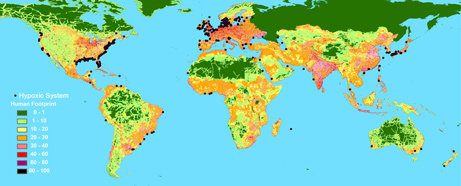
A global map of “dead zones”—where coastal waters contain too little oxygen to sustain life—shows (as black dots) a concentration in the Northern Hemisphere, where human activity has had the most effect.
As of August 2008, there were more than 400 known “dead zones,” scientists said, up from just over 300 in the 1990s. Image courtesy Science/AAAS
“Dead zones” are on the rise, says a new study that identified stark growth in the number of coastal areas where the water has too little oxygen to sustain marine life.
There are now more than 400 known dead zones in coastal waters worldwide, compared to 305 in the 1990s, according to study author Robert Diaz of the Virginia Institute of Marine Science.
Related article: Are the oceans giving up?
